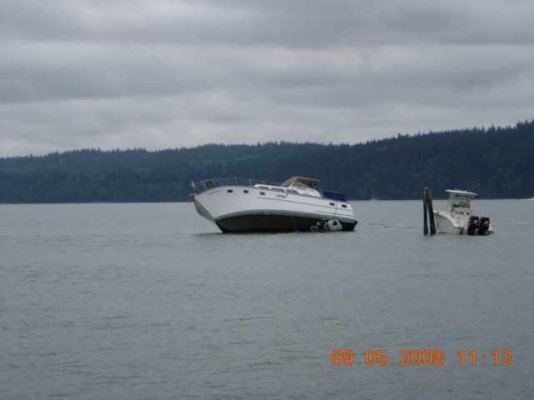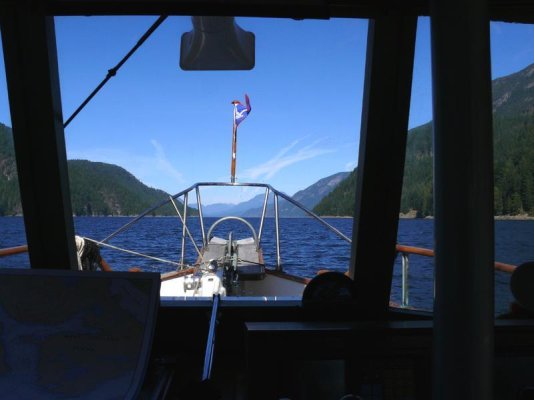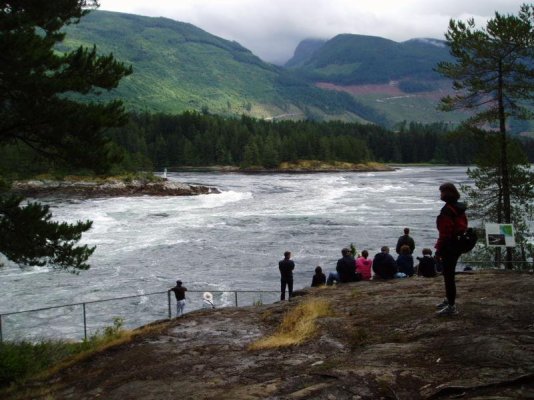Chris Foster
Senior Member
and those who will again...
(Long post - my apologies.* I had thought that I should suggest a new Trawler Forum section called "Confessional" until I realized that I was probably the only one doing sufficiently stupid things to post there).
I thought that I was pretty much immune to going aground, since I had already managed to do so about 15 years ago.* After all, the old saying says that there are two types of boaters, those who have and those that will, and absolutely NOTHING about those who will do it TWICE!!
So there I was last Sunday, approaching the south end of Swinomish channel.* For the non-PNW types, the channel is dredged through an extensive shallow that dries at very low water.* We were approaching from the north, so we needed to keep to the west in deeper water until passing the #1 bouy, indicating the start of the dredged channel.* Then we could turn left (east) into the channel.
Well, it turns out that from a couple of miles out, the #1 and #3 bouys look a whole lot alike.* I ***thought*** that I had scanned the horizon carefully.* Within about a 10 second period, the following took place:
- what the heck is that bouy over there that I didn't notice before?
- why does the boat sound kinda funny?
- uhhh... hard to starboard, quick...
- sudden stop
At this point, I fortunately stopped being stupid and (I think) did things pretty much right.* The first thing that I did was absolutely nothing ... namely, not going into reverse.* Thought*about it for a moment.**The tide was rising, so we should float off in a bit.* Shut down the engines (don't want to plug the cooling water intakes).* Don't do anything stupid.* It's sand/mud bottom, so there's no danger of having damaged the boat (yet, at least).
So after pondering my foolish predicament for a moment, I did notice that both wind and tide were coming from the west, which would tend to push us towards shallower water if we floated off.* Launched the skiff and had someone lower the anchor to me carefully.
Started to row off to drop and anchor as a kedge at 90 degrees to the bow (towards the west - into the wind and current and deeper water).* After about 10 feet, discovered the obvious:* I can't pull chain across the bottom.* Pull the bit of chain that did come out back into the dink, and then had my buddy load about the next 100 feet of chain along with me.
Row - row - row my boat, and the chain happily slowly pulled out as I did.* Got to the end of the chain, and stuck an oar down to find about five feet of water below the dink.* Dropped the anchor in, retreived the oar that I dropped, and rowed back to the boat.
So now we started putting a strain on the anchor chain.* This was to do 3 things:* keep from drifing into shallower water if we did start to float off, pull us into deeper water if possible, and pull the bow around so that we would be heading towards deeper water immediately once we started to float (without having to turn).
Over the next 20-30 minutes, things worked out pretty much as planned.* The anchor set just with the pull of the winch.* After about 10 minutes, you could feel the boat rock just a bit with passing wakes.* Ever so slowly, we could pull in a few inches of chain, and just as slowly, the bow started to come around a few degrees at a time.* In about 20 minutes, the tide had come up to the point that she was balancing on the keel, and you could feel her starting to rock again.* A few minutes later, the bow had come around 90 degrees.* And finally - glory be and saints be praised - she floated off and we could pull in the anchor chain.
Fired up the engines and she moved under her own power.* Retreived the anchor, stowed the dink, and we went on with our day.
In the midst of all of this, I did notice that the GPS plotter in the main cabin showed quite clearly that we were not where we should be.** Of course, we were up on the flybridge, where it did us no good.
So am I immune for another 15 years???
(Long post - my apologies.* I had thought that I should suggest a new Trawler Forum section called "Confessional" until I realized that I was probably the only one doing sufficiently stupid things to post there).
I thought that I was pretty much immune to going aground, since I had already managed to do so about 15 years ago.* After all, the old saying says that there are two types of boaters, those who have and those that will, and absolutely NOTHING about those who will do it TWICE!!
So there I was last Sunday, approaching the south end of Swinomish channel.* For the non-PNW types, the channel is dredged through an extensive shallow that dries at very low water.* We were approaching from the north, so we needed to keep to the west in deeper water until passing the #1 bouy, indicating the start of the dredged channel.* Then we could turn left (east) into the channel.
Well, it turns out that from a couple of miles out, the #1 and #3 bouys look a whole lot alike.* I ***thought*** that I had scanned the horizon carefully.* Within about a 10 second period, the following took place:
- what the heck is that bouy over there that I didn't notice before?
- why does the boat sound kinda funny?
- uhhh... hard to starboard, quick...
- sudden stop
At this point, I fortunately stopped being stupid and (I think) did things pretty much right.* The first thing that I did was absolutely nothing ... namely, not going into reverse.* Thought*about it for a moment.**The tide was rising, so we should float off in a bit.* Shut down the engines (don't want to plug the cooling water intakes).* Don't do anything stupid.* It's sand/mud bottom, so there's no danger of having damaged the boat (yet, at least).
So after pondering my foolish predicament for a moment, I did notice that both wind and tide were coming from the west, which would tend to push us towards shallower water if we floated off.* Launched the skiff and had someone lower the anchor to me carefully.
Started to row off to drop and anchor as a kedge at 90 degrees to the bow (towards the west - into the wind and current and deeper water).* After about 10 feet, discovered the obvious:* I can't pull chain across the bottom.* Pull the bit of chain that did come out back into the dink, and then had my buddy load about the next 100 feet of chain along with me.
Row - row - row my boat, and the chain happily slowly pulled out as I did.* Got to the end of the chain, and stuck an oar down to find about five feet of water below the dink.* Dropped the anchor in, retreived the oar that I dropped, and rowed back to the boat.
So now we started putting a strain on the anchor chain.* This was to do 3 things:* keep from drifing into shallower water if we did start to float off, pull us into deeper water if possible, and pull the bow around so that we would be heading towards deeper water immediately once we started to float (without having to turn).
Over the next 20-30 minutes, things worked out pretty much as planned.* The anchor set just with the pull of the winch.* After about 10 minutes, you could feel the boat rock just a bit with passing wakes.* Ever so slowly, we could pull in a few inches of chain, and just as slowly, the bow started to come around a few degrees at a time.* In about 20 minutes, the tide had come up to the point that she was balancing on the keel, and you could feel her starting to rock again.* A few minutes later, the bow had come around 90 degrees.* And finally - glory be and saints be praised - she floated off and we could pull in the anchor chain.
Fired up the engines and she moved under her own power.* Retreived the anchor, stowed the dink, and we went on with our day.
In the midst of all of this, I did notice that the GPS plotter in the main cabin showed quite clearly that we were not where we should be.** Of course, we were up on the flybridge, where it did us no good.
So am I immune for another 15 years???



